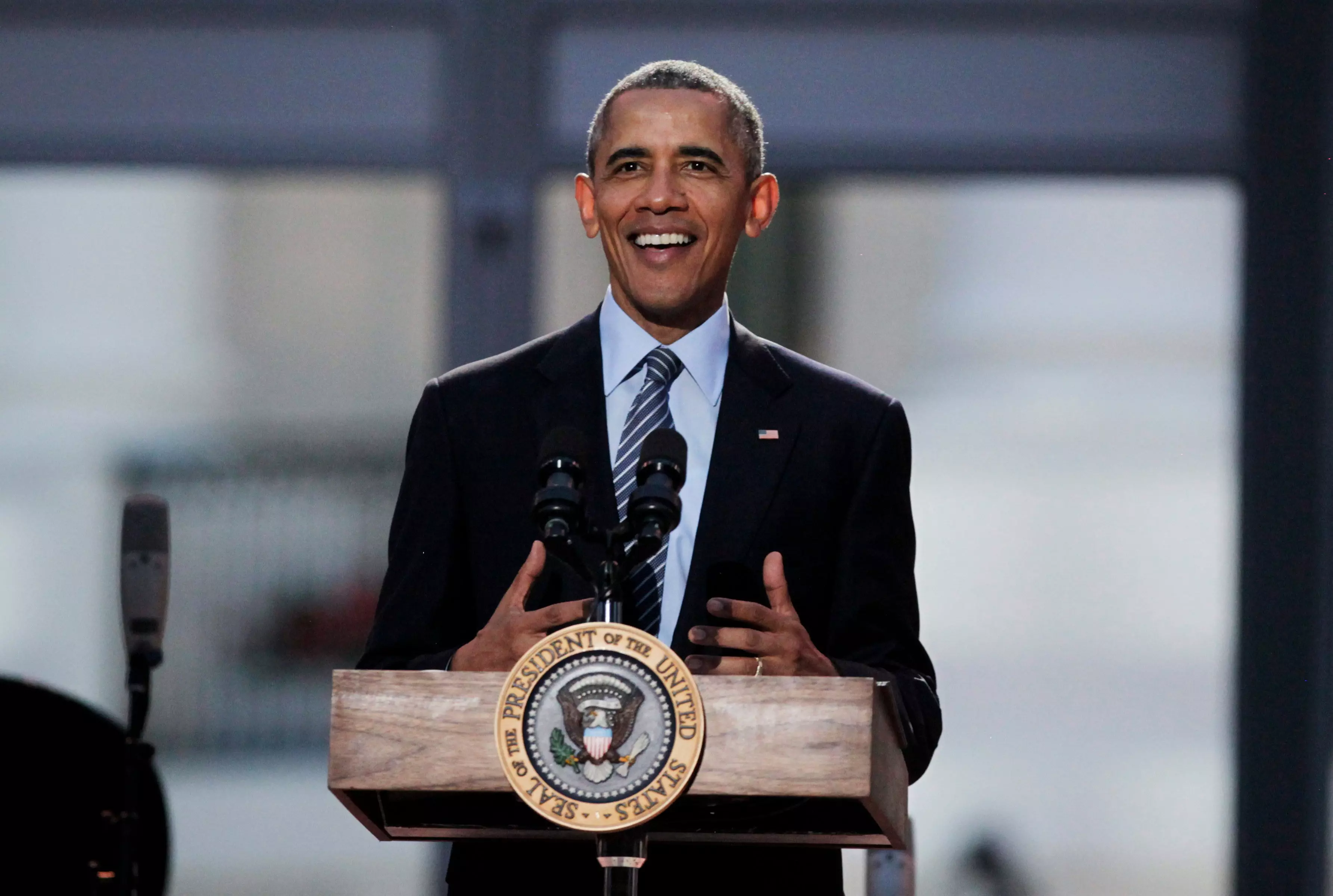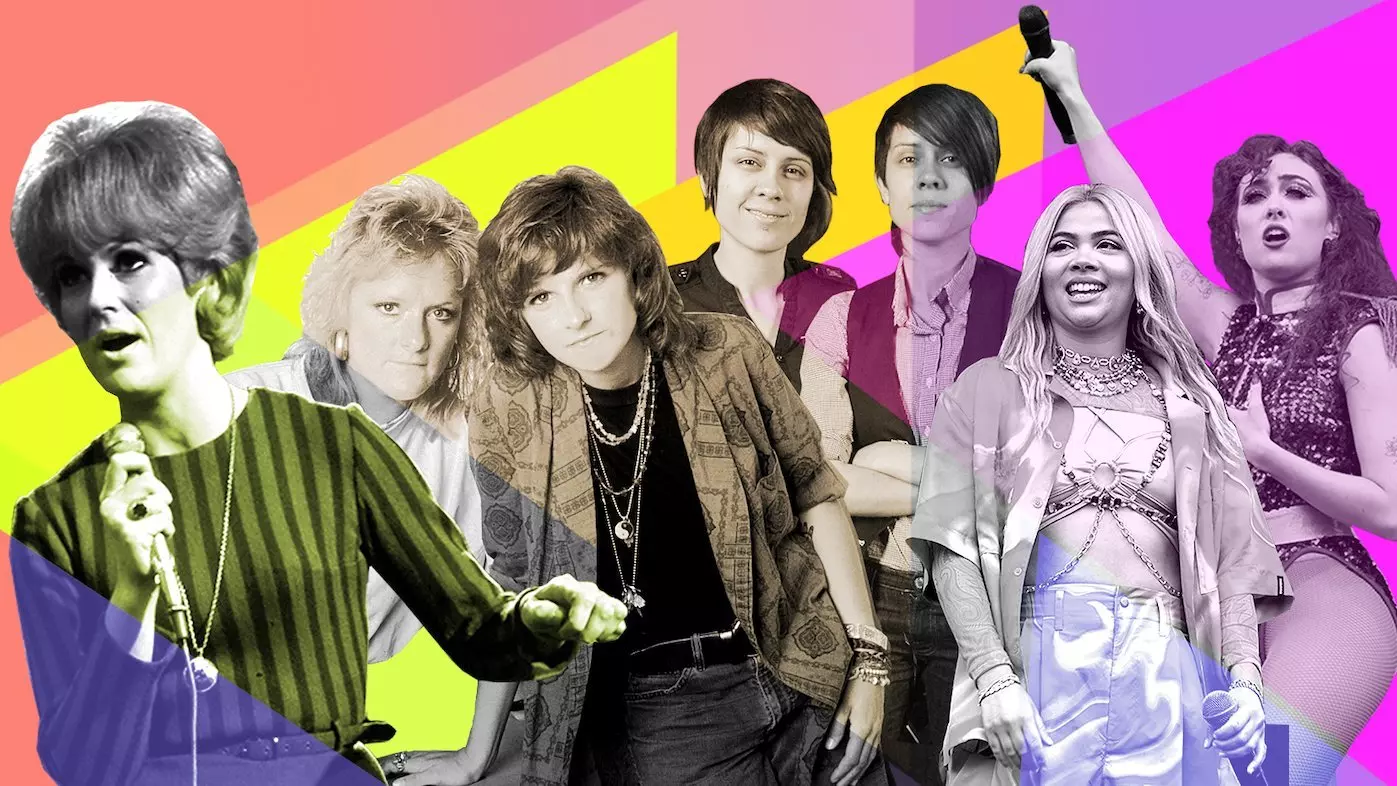Photo: Tasos Katopodis/Getty Images for The Recording Academy
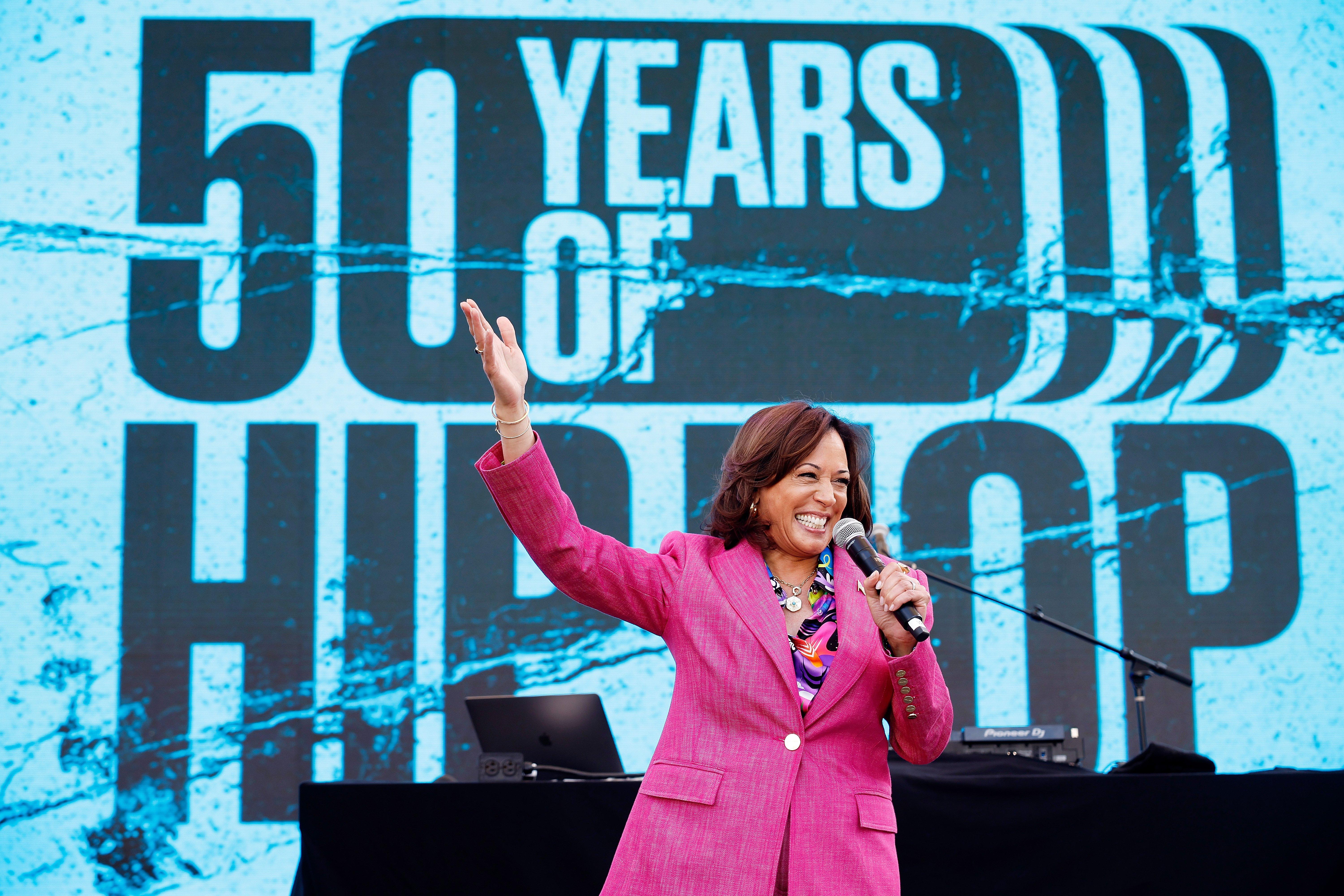
news
How Vice President Kamala Harris And The Recording Academy Celebrated The 50th Anniversary Of Hip-Hop: "Hip-Hop Culture Is America's Culture"
Presented by Live Nation Urban, the Recording Academy's Black Music Collective, and the U.S. Vice President's office, the once-in-a-lifetime event celebrated 50 years of hip-hop with multiple performances from Lil Wayne, Common and more hip-hop luminaries
"Welcome to the first-ever hip-hop house party at the home of the Vice President of the United States," U.S. Vice President Kamala Harris said excitedly from a lively stage propped up in her backyard. Her words reminded folks of the Notorious B.I.G.'s eternal lyrics: "You never thought that hip-hop would take it this far."
Indeed, as guests gathered at Vice President Harris' residence in Washington, D.C., on Saturday for a private, intimate event celebrating the 50th anniversary of hip-hop, a palpable sense of wonder and awe, mixed with waves of laughter and bliss, overtook the energized crowd. Here we were, honoring hip-hop in the home of the Vice President, with rap classics blasting from the stage as the unrelenting D.C. sun kept attendees beaming and alive.
The celebration, co-presented by Live Nation Urban and the Recording Academy's Black Music Collective, recognized hip-hop's global influence, evolution and long-lasting impact and brought together music industry professionals, U.S. Senators and Governors, politicians, and celebrated rappers — all true fans of and believers in the power of hip-hop.
Among them, Vice President Harris was perhaps the most vocal hip-hop supporter of them all. In an impassioned, heartfelt speech, she boasted of the immeasurable impact hip-hop has made on American culture.
"Hip-hop is the ultimate American art form … Hip-hop now shapes nearly every aspect of America's popular culture," she said. "And it reflects the incredible diversity and ingenuity of the American people.
"Hip-hop culture is America's culture," she continued. "It is a genre. It is music, melody and rhyme. And hip-hop is also an ethos of strength and self-determination, of ambition and aspiration, of pride, power, and purpose."
Second Gentleman Douglas Emhoff, who confirmed with the audience that his home with Vice President Harris is, as a matter of fact, a "hip-hop household," echoed the sentiment in his opening remarks, emphasizing that the event aimed to "celebrate the legends who pioneered the music we love, the next generations who will carry on their legacy, and the artists and producers who use the power of music to create change."
For the Recording Academy, the celebration was a historic milestone in the evolution of hip-hop music and culture as a whole and the latest installment in the organization's year-long celebration of 50 years of hip-hop. In February, hip-hop took over the 2023 GRAMMYs with a special, star-studded tribute to hip-hop's 50th anniversary featuring performances from rap pioneers (Grandmaster Flash, Run-D.M.C., Chuck D, Flavor Flav), modern legends (Busta Rhymes, Missy Elliott, Lil Wayne), and next-gen stars (GloRilla, Lil Baby). Now, from the GRAMMYs stage to the Vice President's backyard, hip-hop is everywhere, and the genre's impact has touched virtually every aspect of global pop culture.
"Now, fifty years later, there's not a single genre of music that hasn't absorbed something essential from hip-hop," Recording Academy CEO Harvey Mason jr. said in a speech as he introduced "the first Vice President of the hip-hop generation."
"Our Vice President was rooted in hip-hop. It is essential to who she is. And — as today shows — she has brought hip-hop with her to the White House," he continued.
The multifaceted event featured a variety of performances and speeches celebrating the five core pillars of hip-hop: MCing, DJing, breakdancing, graffiti and beatboxing. As performers like legendary beatboxer Doug E. Fresh, DJ Dom and DJ D-Nice commanded the stage, Bboy Gravity and his breakdance crew wowed the audience with their neck-breaking moves; throughout the event, a graffiti artist completed a live graffiti mural wall painting from beginning to end.
"This event perfectly embodied everything that we at the Black Music Collective are about, and it's been the honor of a lifetime to work alongside other industry leaders and Vice President Kamala Harris to curate this historic celebration," Ryan Butler, the Recording Academy's Vice President of Diversity, Equity & Inclusion, said in a statement. "We chose to focus on five key pillars of hip-hop — MC, DJ, breakdance, graffiti and beatbox — which allowed us to celebrate all of the distinct elements of such a culturally significant movement."
A powerful lineup of artists further framed the five elements of hip-hop. Remy Ma, MC Lyte and Roxanne Shanté showcased some of the many ways women have influenced hip-hop culture, while Bay Area rapper Too $hort represented the West Coast with his performance of his classic hits "Life is Too $hort" and "Blow the Whistle." Common's freestyle-fueled performance exemplified the higher-learning, conscious-expression aspect of hip-hop, while fellow Chicago rapper Saba held it down for the fresh faces of hip-hop. The event also featured performances by legendary rappers Fat Joe, Slick Rick, Doug E. Fresh, D.C.'s own Wale, Jeezy, who performed his fitting hit "My President," and Lil Wayne, who delivered a show-stopping, career-spanning closing set.
As the event ended, an ominous thunderstorm loomed up in the clouds, but that didn't stop attendees from basking in the afterglow, snapping their final selfies and videos of what was truly a once-in-a-lifetime experience.
Too $hort best summed up that sense of unbelievable astonishment.
"The journey of hip-hop was not projected to be this," Too $hort said during an on-site interview. "It's a beautiful thing that the image of the culture has changed enough to be used as a tool … Every aspect of life is influenced by hip-hop. Nobody expected that … But at the same time, we were relentless enough to keep doing our craft, and now we're here — we're here! I can't believe I'm here."
*— With additional reporting from John Ochoa*

Photo: Aude Guerrucci-Pool/Getty Images
list
Rocking The White House: 9 Presidents & Vice Presidents Who Love Music
From Richard Nixon's piano to Barack Obama's Spotify playlists, learn about the presidents and veeps who have a demonstrated affinity for music.
Music has long been used as a powerful vehicle on campaign trails to hype up crowds and get them excited to vote in elections. Regardless of which side of the aisle they’re on, a number of politicians who have held the highest offices in the country possess a deep connection to music, whether collecting records or playing instruments.
American presidents and vice presidents have won and been nominated for golden gramophones in the Spoken Word Album category, and a few of the honorees are or were also musicians themselves. (These musical politicians are not to be confused with the actual bands Vice President and the Presidents of the United States of America, of course.)
As the 2024 presidential election comes ever closer, we press pause to enjoy a few fun, nonpartisan facts about how presidents and vice presidents have shown their affection for music.
Read more: GRAMMY-Winning U.S. Presidents & Politicians: The Obamas, Jimmy Carter & More
Kamala Harris
Between a live appearance with Megan Thee Stallion and official campaign posts rendered in the same shade of neon green that Charli XCX is rocking right now, Vice President Kamala Harris has been having a Hot Brat Girl Summer in music. But Harris' love of music extends far beyond the campaign trail.
The current Democratic nominee for president has been endlessly memed for the vinyl albums she was caught buying at a DC record store in 2023. While many images have manipulated the covers to pretend she purchased different releases, she actually bought albums by Charles Mingus and Roy Ayers as well as Porgy & Bess by Ella Fitzgerald and Louis Armstrong. Last year she celebrated the 50th anniversary of hip hop with a star-studded concert at the Vice President’s residence, co-hosted by the Recording Academy. At the 2024 Democratic National Convention, Harris was nominated in a music-themed role call that saw each of the 50 states present with a representative song.
Second Gentleman Doug Emhoff is also a serious jazz fan.
Donald Trump
Although former President Donald Trump is not a known record collector, songwriter or musician, he has culled the favor and interest of a variety of artists. The current Republican nominee for president has been mentioned in many songs over the course of his professional and political career.
In 2018, Trump brought Kid Rock, John Rich, Kanye West (who, years later, would announce his own bid for president) and others to the White House on the day he signed the Music Modernization Act into law. At the 2024 Republican National Convention in Milwaukee, country band Sixwire, Chris Jansen, and Kid Rock performed.
Barack Obama
Former President Barack Obama put music in the spotlight during his two terms in office. He tapped Beyoncé and Janelle Monáe to perform at his inaugurations, awarded Diana Ross the Presidential Medal of Freedom in 2016, invited countless artists to the White House, and even was known to sing on occasion.
Obama won two GRAMMYs in the Best Spoken Word Album Category for audio adaptations of his memoir Dreams from My Father (2005) and The Audacity of Hope: Thoughts on Reclaiming the American Dream (2007); he was nominated for a third in 2022. Most recently, he collaborated with Bruce Springsteen on the book and podcast called Renegades.
Obama's role as a tastemaker really took off in 2015, when he started making and sharing playlists of his favorite songs on Spotify. His wide-ranging picks are still highly anticipated each year, and artists who land on the lists have coveted spots that all but guarantee new plays.
His Summer 2024 Playlist features classics by Tupac, Jill Scott and the Rolling Stones as well as new tunes by artists such as Shaboozey, Tommy Richman, H.E.R. and Tems. Charli XCX even makes an appearance, so Obama also appears to have gone Brat for the season as well.
Bill Clinton
When former Arkansas governor Bill Clinton ran for president in 1992, he stopped by the then-popular night time program "The Arsenio Hall Show" and charmed America with his surprise sax playing in sunglasses, unleashing Elvis Presley’s "Heartbreak Hotel" and "God Bless the Child" by Billie Holiday.
Once elected, the horn would later come out in the White House for parties. The L.A. Sax Company even presented him with a flag-bedecked Presidential Model tenor saxophone in 1995, and it has been on display at The Met in New York City.
At the 47th GRAMMY Awards, Clinton took home the golden gramophone for Best Spoken Word Album for his memoir, My Life. He was also nominated in the same Category in both 2007 and in 2012.
George H.W. Bush
When the elder George Bush, who was president from 1989-1993, played the air guitar at his inauguration, it was unseen lore to the general public for years. The moment was edited out of the official DVD release, but video from the event was restored in 2018, confirming for the public that he had actually done it.
Richard Nixon
Former President Richard Nixon, who served from 1969 to 1974, had a real thing for tickling the ivories. He shared his penchant for the piano with the public when he was a senator, after Duke Ellington asked Nixon to play for him. His talent went wide during a 1961 appearance on the TV show "The Jack Paar Program" and later inspired the title of a 1995 book called Nixon’s Piano: Presidents and Racial Politics from Washington to Clinton. And, as president, the image of him shaking hands with Elvis Presley in the Oval Office remains one of the most iconic pictures in White House history.
In 1978, Nixon was nominated for a GRAMMY in the Best Spoken Word Recording Category for the album made from his televised interviews with David Frost called The Nixon Interviews With David Frost.
Harry S. Truman
Another Best Spoken World Recording nominee was Harry S. Truman, who served as President from 1945 to 1953, and was recognized for The Truman Tapes, a recording made of his interview "speaking frankly" with Ben Gradus. Truman grew up playing the piano and made the choice to focus instead on politics.
"My choice early in life was either to be a piano-player in a whorehouse, or a politician," he reportedly said. "And to tell the truth, there’s hardly any difference."
Classic rockers Chicago later released a song called "Harry Truman" in 1975, singing, "Harry, could you please come home?/Things are looking bad/I know you would be mad/To see what kind of men/Prevail upon the land you love."
Charles Dawes
When former President Calvin Coolidge served for six years in the Roaring Twenties (1923-1929), he was flanked by a hitmaking VP. Charles Dawes didn’t know when he wrote "Melody in A Major" in 1912 that it would later become the basis of a top 40 hit.
Singer Tommy Edwards later landed on the pop charts in 1951 with the melody of "Melody," now called "It’s All in The Game." The song became a highly covered standard, with popular versions recorded by Elton John, Barry Manilow and Van Morrison. No subsequent president or vice president could match that high bar.
Warren G. Harding
Coolidge’s presidential predecessor Warren G. Harding (1921-1923) was said to be a multi-instrumentalist who loved to blow the tuba. He played the hulking brass beast at the 1920 Democratic National Convention. While we haven’t seen that kind of lung power on display at the DNC or RNC this year, let this serve as a reminder that music unites and brings joy.
Latest News & Exclusive Videos
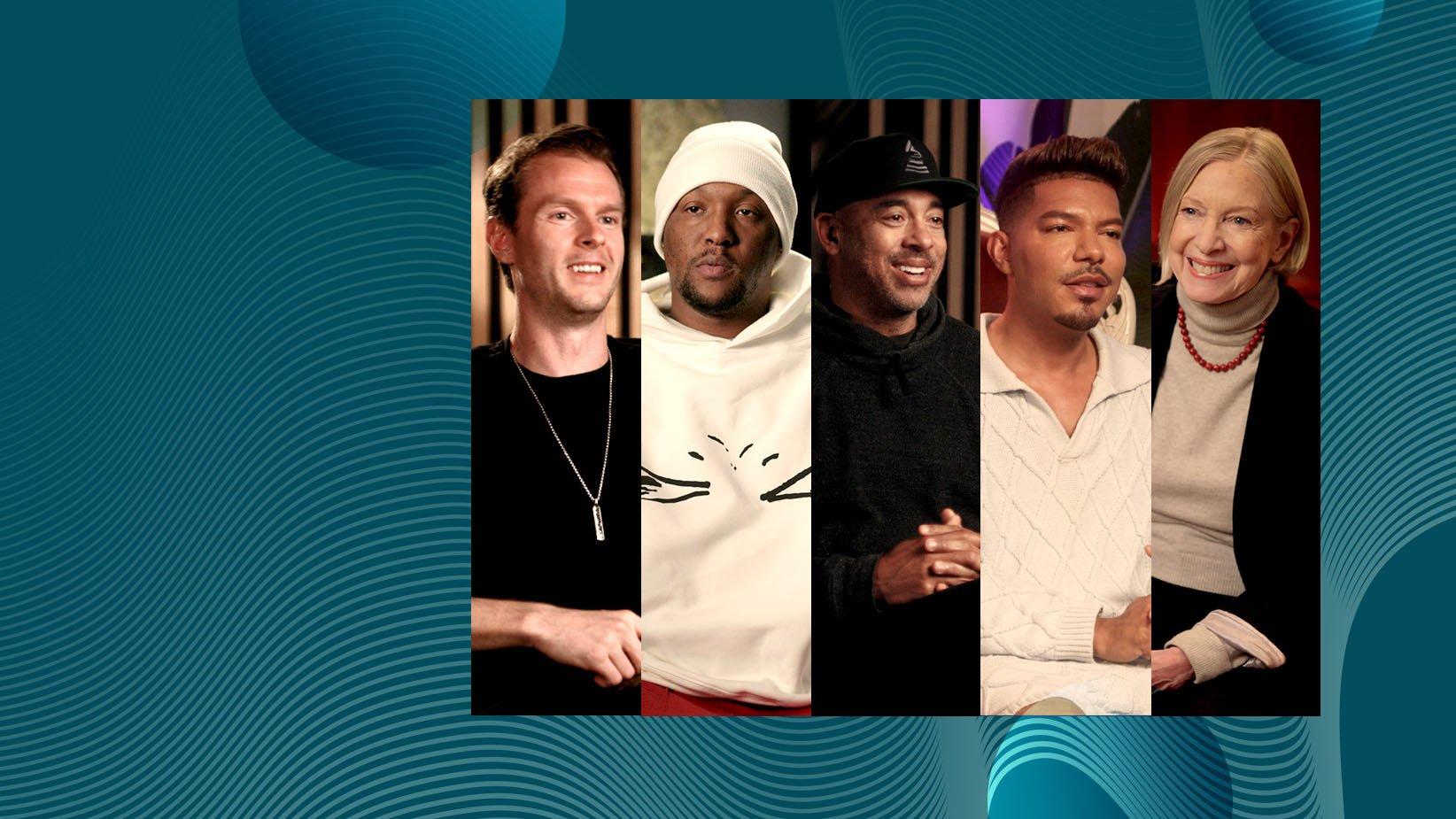
Photos Courtesy of the Recording Academy
news
The New GRAMMY GO Music Production Course Is Now Open: Featuring GRAMMY Winners Hit-Boy, CIRKUT, Judith Sherman & More
Enrollment is now open for GRAMMY GO's new specialization, "Music Production: Crafting Award-Worthy Songs," featuring appearances by GRAMMY winners and nominees. Learn music production and creative strategies from today's industry leaders.
Editor’s Note: Updated to add the Instagram Live video featuring Harvey Mason jr. and Stevie Mackey.
The Recording Academy continues its mission to empower music's next generation with the launch of its second specialization in the GRAMMY GO platform: "Music Production: Crafting Award-Worthy Songs."
This new course, a partnership between the Recording Academy and leading online learning platform Coursera, aims to bolster the technological and audio skills of music producers of all levels. The course, taught by Howard University professor and GRAMMY nominee Carolyn Malachi, features appearances by three-time GRAMMY winner and rap icon Hit-Boy, chart-topping and GRAMMY-winning producer/songwriter CIRKUT, artist and celebrity vocal coach Stevie Mackey, five-time GRAMMY nominee and Recording Academy CEO Harvey Mason jr., and 15-time GRAMMY winner Judith Sherman.
Enrollment for "Music Production: Crafting Award-Worthy Songs" is open now.
Mixing a unique blend of theory and practice, the course teaches music creators of all levels the advanced skills and tools to develop the mindset and confidence of an experienced producer and produce songs of the highest industry standards across all genres. Explore the wide-ranging roles of a music producer, develop critical listening and analysis skills, and master the technical aspects to create music and compositions that cut through the noise. The course's applied learning approach allows learners to sharpen their pre-production skills, utilize Digital Audio Workstations (DAWs) effectively, and produce vocals, instrumentals and samples collaboratively. Through critical listening exercises and discussions, learners will refine their abilities to deliver professional-quality demos.
To celebrate the launch, the Recording Academy hosted an Instagram Live session on Tuesday in which guests Harvey Mason jr. and Stevie Mackey discussed the evolving role of music producers, strategies for working with artists, key elements of top-notch productions, common mixing mistakes, tips for keeping the creative process fresh, and enrollment details for the course.
Building on the success of its first specialization, "Building Your Audience for Music Professionals," GRAMMY GO continues to offer industry-focused education tailored for emerging and established music creators and professionals alike. The innovative platform provides learners with real-time insights from leading music industry figures, ensuring the content remains practical and up to date. GRAMMY GO will also serve as an essential tool in the Recording Academy's global expansion into Africa and the Middle East, empowering music creators through enhanced training, bridging knowledge gaps, and fostering connections within the global music community.
Launched in April in partnership with Coursera, GRAMMY GO is the Recording Academy's first creator-to-creator platform, offering innovative courses tailored for both emerging and established music professionals. The initiative accelerates the Academy's global mission and reinforces its commitment to music education, providing a seamless bridge between all Academy initiatives.
Learn more about GRAMMY GO and the "Music Production: Crafting Award-Worthy Songs" and "Building Your Audience for Music Professionals" specializations.
Watch the Instagram Live session with Harvey Mason jr. and Stevie Mackey in full below:
More Music Education News & Initiatives
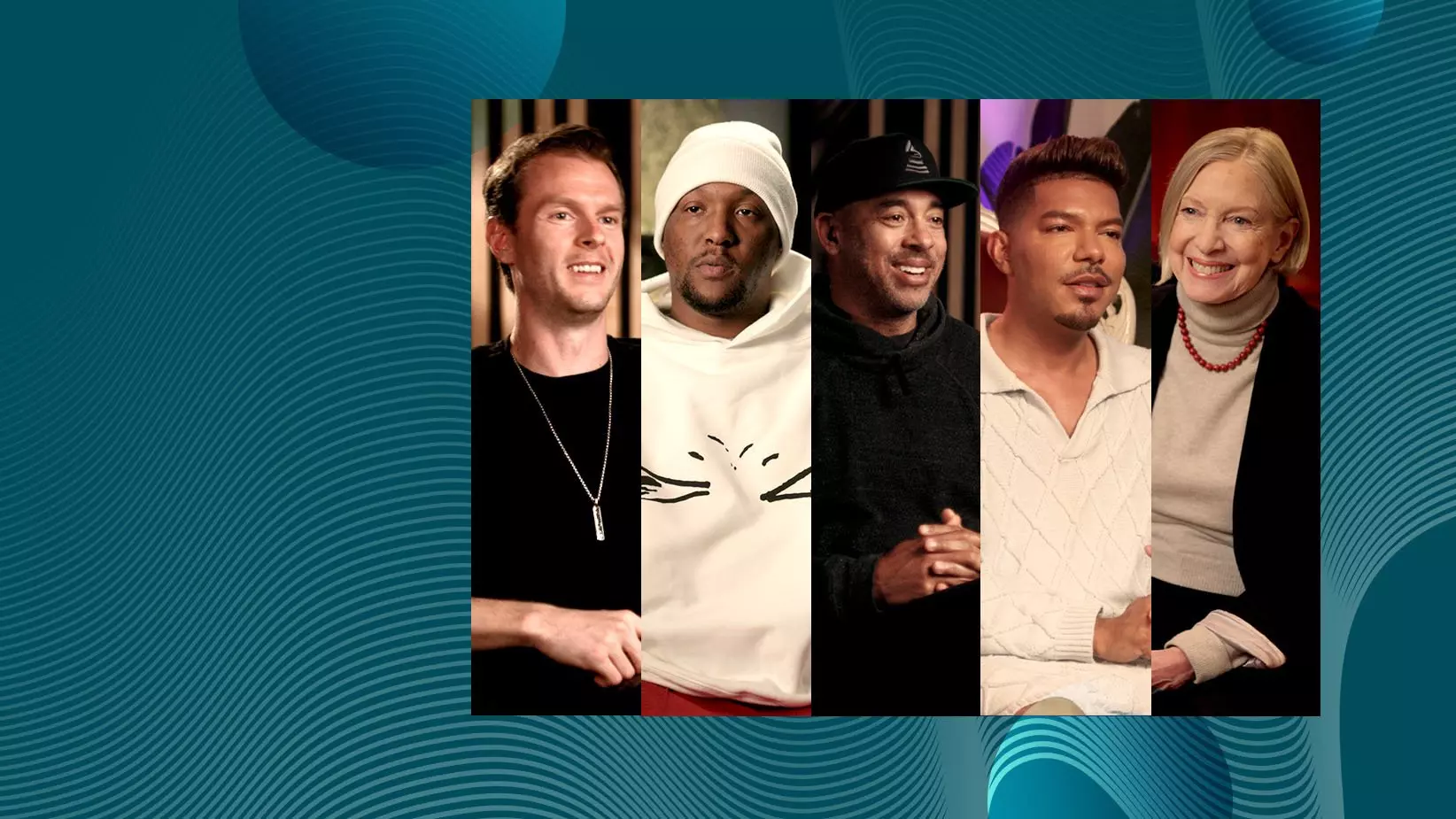
The New GRAMMY GO Music Production Course Is Now Open: Featuring GRAMMY Winners Hit-Boy, CIRKUT, Judith Sherman & More
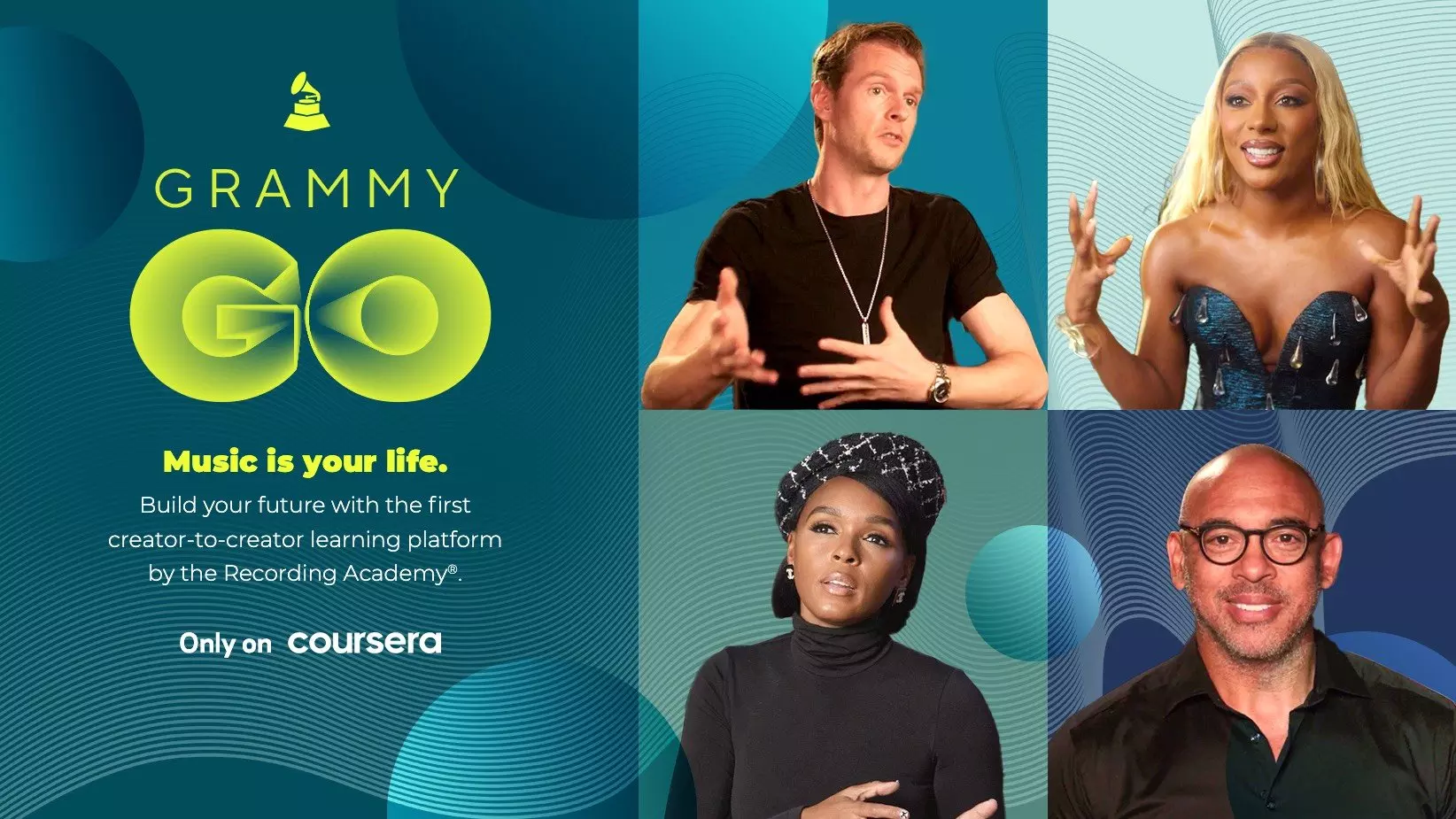
Recording Academy & Coursera Partner To Launch GRAMMY GO Online Learning Initiative

25 Semifinalists Announced For The 2024 Music Educator Award

5 Music Teachers Share The Transformative Power Of Music Education
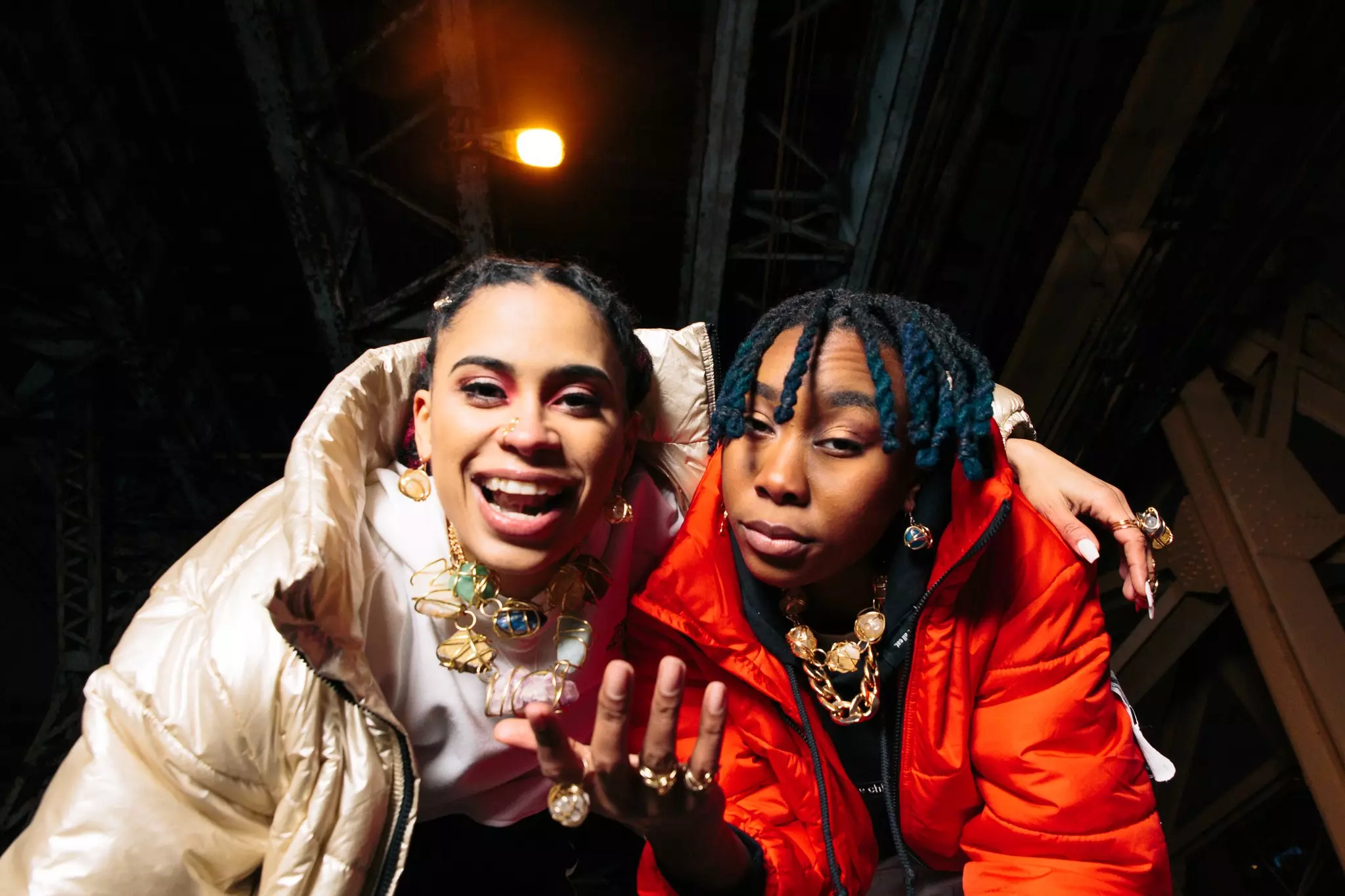
Meet Mother Nature, The Chicago Rap Duo That Teach & Live Self-Expression Through Their Miseducation Of HipHop Youth Workshops
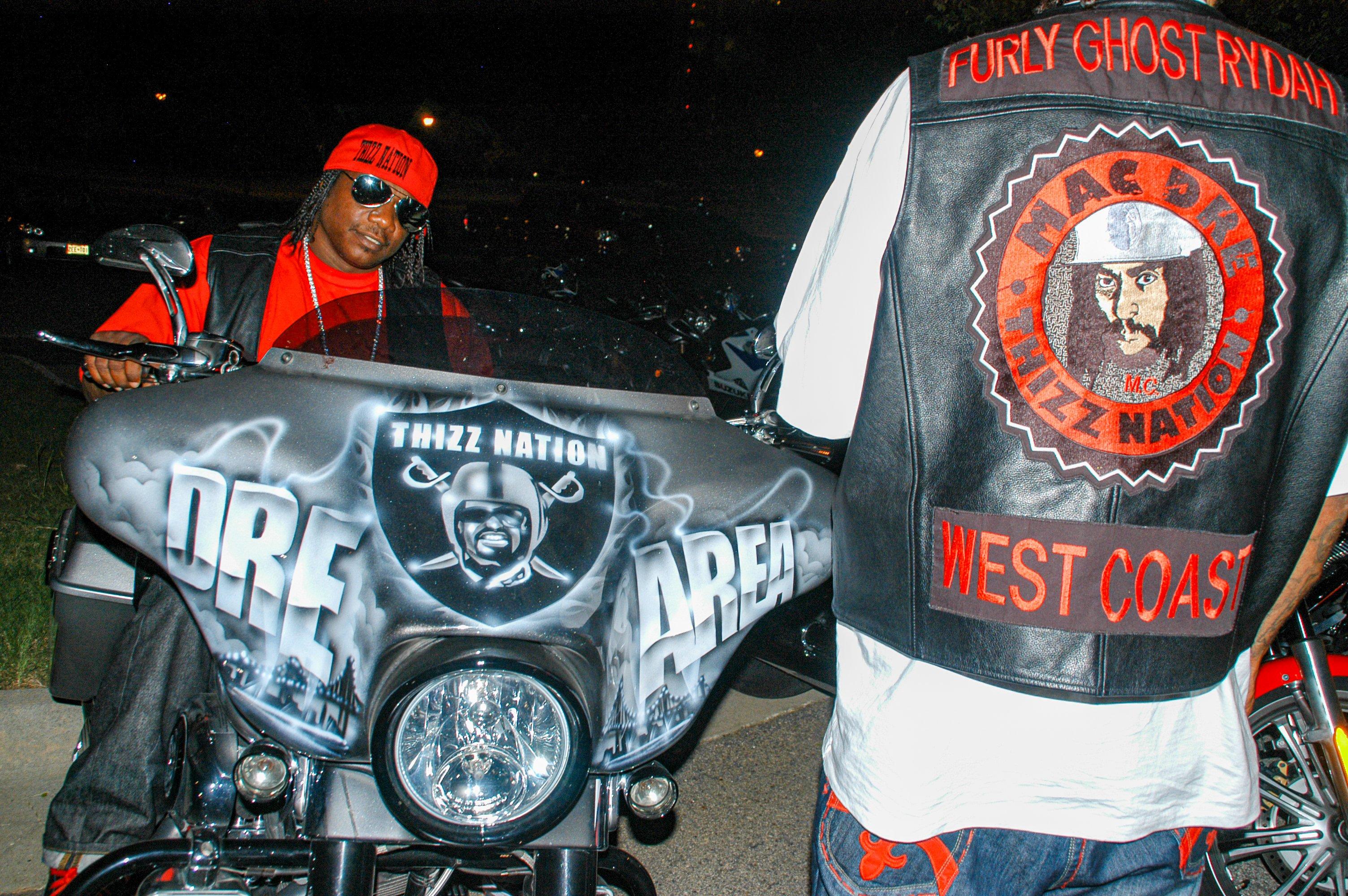
Photo: Julia Beverly/Getty Images
list
5 Ways Mac Dre's Final Living Albums Shaped Bay Area Rap
The rapper was killed just months after the simultaneous release of 'Ronald Dregan: Dreganomics' and 'The Genie of the Lamp.' Twenty years later, read on for how the releases that gave the world "Get Stupid" and "Feelin' Myself" reverberate in hip-hop.
Nearly two decades after his still-unsolved murder took place, Mac Dre remains one of Bay Area rap’s definitive artists and guiding spirits. The rapper born Andre Hicks helped to pioneer and steer the region’s hyphy movement — a music, linguistic, car and party culture that influenced rap and even electronic music globally.
Mac Dre released both his ninth album, Ronald Dregan: Dreganomics, and his 10th album The Genie of the Lamp on the same day: July 20, 2004. Although Mac Dre had been a key figure in the Bay's rap game for years, the two records were some of his most influential, and are now classics in the canon of early aughts hip-hop. The more popular of the pair, Ronald Dregan features "Feelin’ Myself" and "Get Stupid," party anthems that borrowed from rave culture’s sunnier outlook to give architectural shape to the emerging hyphy movement.
Learn more: 11 Hip-Hop Subgenres To Know: From Jersey Club To G-Funk And Drill
Mere months later, Mac Dre was killed in a drive-by shooting on a highway in Kansas City, Missouri on Nov. 1, 2004. His death still stings in grim contrast to the joy, fun and charisma that he brought to his music and live performances. "When Mac Dre got killed, it was like Martin Luther King in the Bay," rapper Too $hort told Revolt in 2022. "It was that kind of loss."
Fortunately, Ronald Dregan: Dreganomics and The Genie of the Lamp preserved him at his happiest musical peak. Twenty years later, GRAMMY.com examines how Mac Dre’s final living albums not only kickstarted a massive posthumous career and movement, but have remained musical and business inspirations for artists in Northern California and beyond.
They Hyped Up Hyphy
Mac Dre put out a DVD called TREAL TV in September 2003 that quickly became legendary throughout the Bay Area. The use of ecstasy and other party drugs most associated with raves at the time became a major theme in the hyphy music that came after his death, and TREAL TV features Mac Dre clowning around, cable access TV style, while intoxicated. ("I’m as high as a fire escape… I’m on everything right now," he says with a grin.)
There’s also footage of him performing live in small towns in Northern California and the Northwest, where people danced with hyper energy (and possibly those aforementioned drugs)and rapped along with all the words. It was the first time many people got to see how physically animated and infectious Mac Dre was as a performer. Bay Area rap music that came in the immediate years before him was largely a lot slower and more serious — one subset is even called "mobb music," suggesting sinister overtones. But TREAL TV showed how cool it was to be a happy gangster.
The momentum of TREAL TV, followed by the double album drop, brought Mac Dre to the forefront of the Bay Area’s burgeoning hyphy movement. Alongside fellow East Bay artist Keak da Sneak and hyphy-themed hits by veteran local artists Too $hort and E-40 produced by Atlanta’s Lil Jon, they would put the Bay Area back on the rap map for major record labels to sign and promote to the world.
Read more: A Guide To Bay Area Hip-Hop: Definitive Releases, Artists & Subgenres From Northern California
They Established Politics As Unusual
The political theme of Ronald Dregan: Dreganomics introduced a humorous political angle for Mac Dre’s songs. This theme would continue even after his passing, via posthumous works released by his mother "Mac" Wanda Salvatto on his Thizz Entertainment label.
Two popular posthumous compilations imagine the rapper in a high office: 2007’s Mac Dre Is Pill Clinton and 2008’s Dre Day - July 5th 1970. The latter features a cover illustration depicting Mac Dre as Uncle Sam with a thizz face (an expression he coined to describe a frown induced by happiness and getting intoxicated).
They Kept It P
There has always been a number of Bay Area artists who have been influenced by Oakland’s pimp culture, which was famously depicted in the 1973 movie The Mack. Some really tried their hand at the adult business, while others just rapped about it.
Both Ronald Dregan: Dreganomics and The Genie of the Lamp come from a perspective of pimping. Musically and lyrically, the former is more lighthearted and party-oriented, while the latter is more overtly street-focused and aggressive. On "My Alphabets" — a collaboration with Suga Free and Rappin’ 4-Tay, California rappers known for rapping heavily about the profession — Dre raps, "You can’t con me/ I’ll slice yo ass thin as salami."
While by no means the only topic tackled in Bay Area rap at the time or today, Mac Dre did his part to keep it alive within the culture, for better or worse, for decades after his death.
They Allowed Mac Dre To Have Life After Death
Without the attention generated by TREAL TV, Ronald Dregan: Dreganomics and The Genie of the Lamp, Mac Dre would not have had the outsized posthumous career that he does. Mac Wanda has lovingly kept her son’s musical legacy alive with the aforementioned posthumous releases and via her own interviews for research projects such as the 2015 documentary Mac Dre: Legend of the Bay.
Just like the late Tupac Shakur’s estate has done, Mac Dre’s posthumous catalog is both robust and highly bootlegged. Official releases on the Thizz Entertainment label have given opportunities to artists in the Bay Area and even in Alaska to share their music with the world through albums and various artist compilations.
They Spawned Many Living Tributes
Mac Dre has had a lasting effect on artists in the generations that have come after him, in the Bay Area and beyond; see Drake and Lil Wayne’s "The Motto" (2011), which interpolates lyrics from Dre’s "Feelin’ Myself," or "Stupid," the new single from YG featuring Lil Yachty and Babyface Ray, which references ecstasy and Mac Dre’s use of the word stupid as a positive term.
Mistah F.A.B.’s 2016 song "Still Feelin’ It" is one of many tributes he’s done in Mac Dre’s memory and offers vivid evidence of how the late MC influenced him to become a strong songwriter, entrepreneur and philanthropist. And you’ll hear echoes of Mac Dre (both figuratively and literally via samples) in promising Bay Area artists who were too young to know Mac Dre, like Guapdad 4000, who released a "Mac Dre Freestyle" that references "Dreganomics" in 2024.
Mac Dre Day events, typically held on or around July 5 to celebrate his birthday, have been a staple in various Northern California cities since his passing. For many, they are a rite of passage of growing up in the Bay Area rap scene. Whether revisiting or listening for the first time, Mac Dre’s 2004 albums still sound fun in 2024, a testament to the lasting legacy of a late artist from the San Francisco Bay Area who just wanted to make his mark.
More Rap News
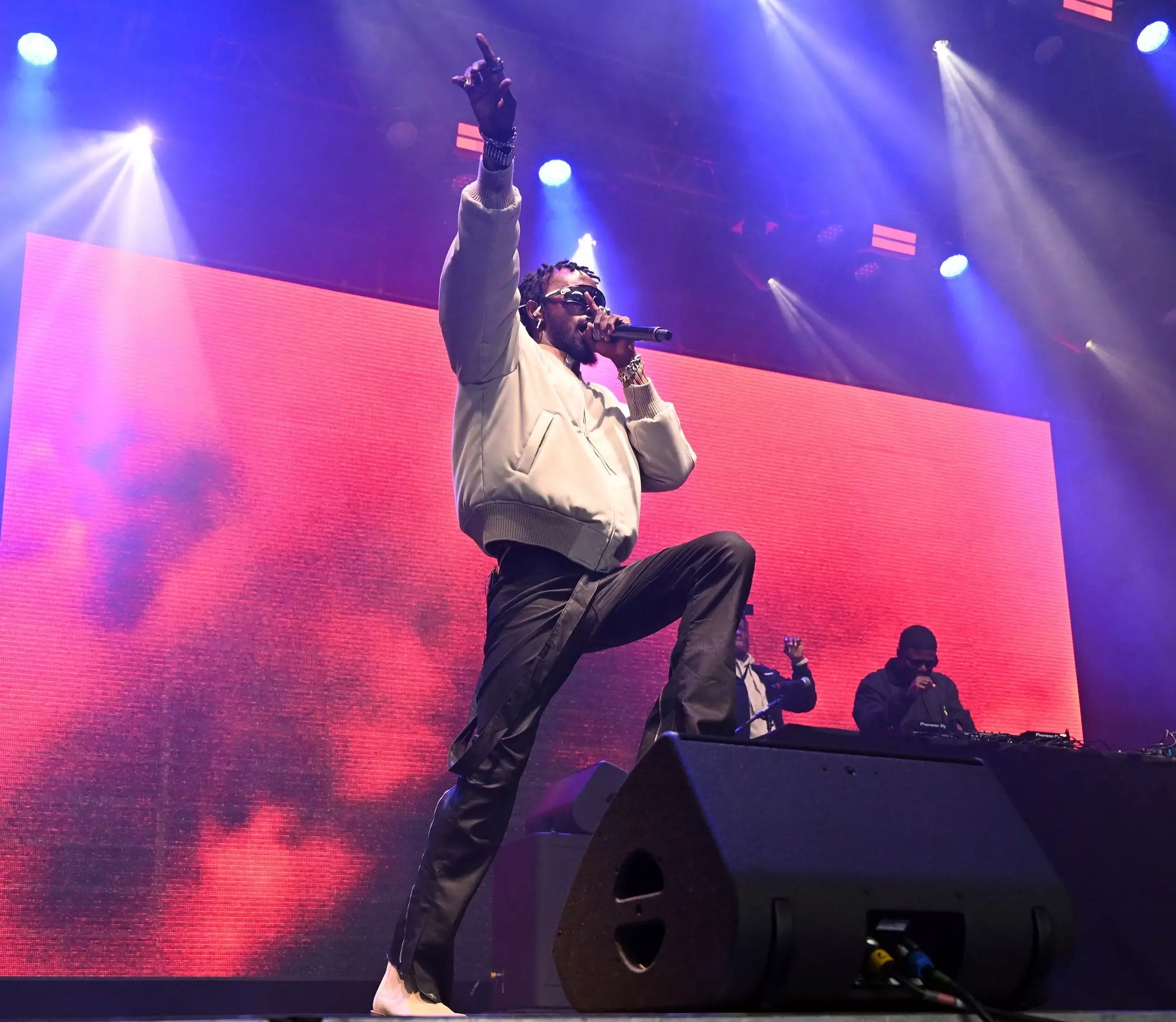
10 Artists Essential To Ghanaian Hiplife: Reggie Rockstone, Sarkodie, Mzbel & More

Ice Spice Is The Drill Queen On 'Y2K!': 5 Takeaways From Her Debut Album

Watch Young MC Win Best Rap Performance In 1990

On Rakim's 'G.O.D's Network (REB7RTH)' The MC Turned Producer Continues His Legacy With An All-Star Cast

5 Ways Mac Dre's Final Living Albums Shaped Bay Area Rap
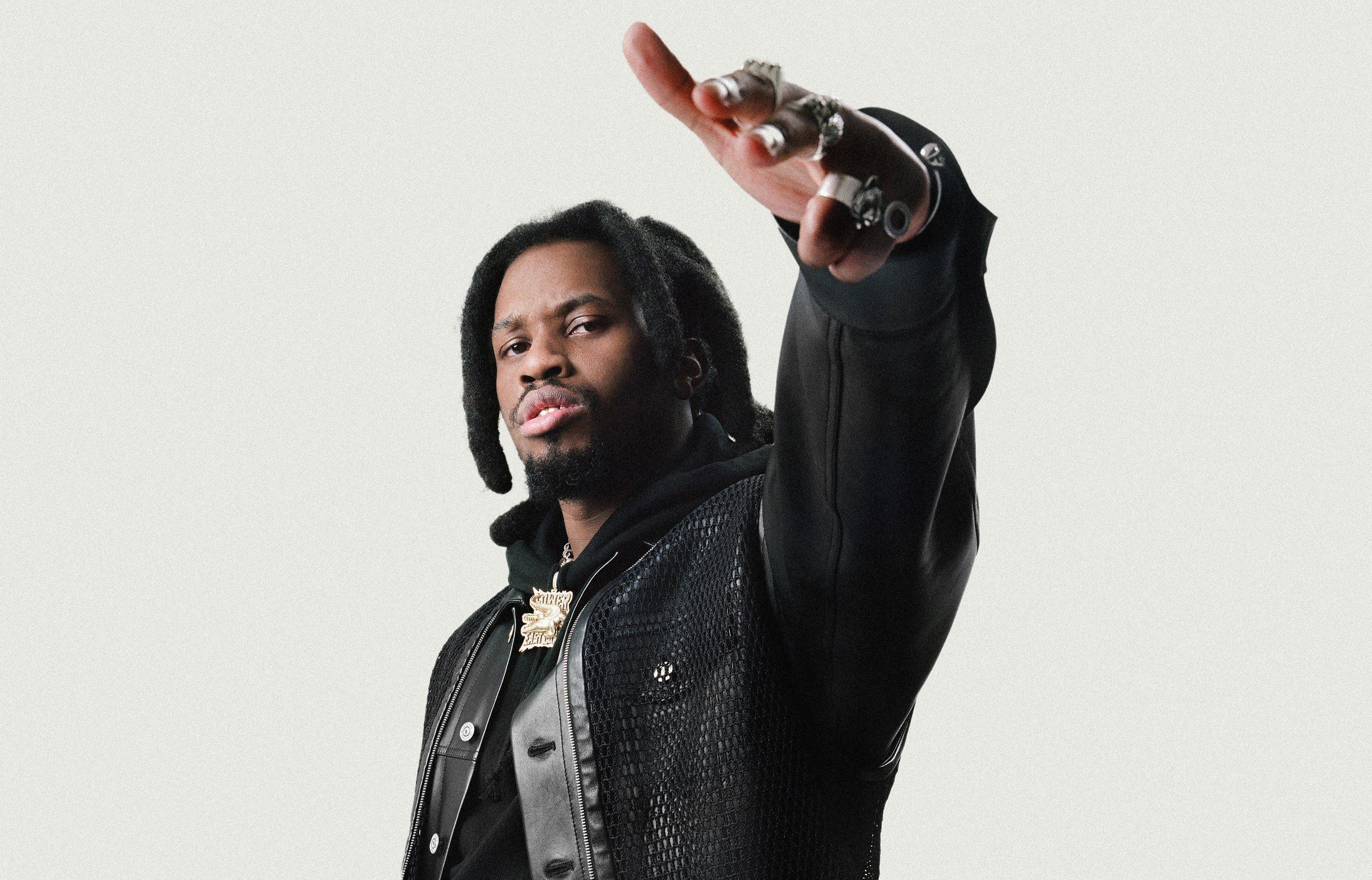
Photo: Giovanni Mourin
interview
Denzel Curry Returns To The Mischievous South: "I've Been Trying To Do This For The Longest"
Over a decade after he released 'King of the Mischievous South Vol. 1,' Denzel Curry is back with 'Vol. 2.' The Miami rapper details his love of Southern hip-hop, working on multiple projects, and the importance of staying real.
Denzel Curry isn’t typically one for repetition. His recent run of critically acclaimed projects have all contrasted in concept and musicality.
The Miami Gardens native has cascaded through boom-bap, synth-soaked trap metal, and cloud rap throughout his catalog. But on his upcoming project, King of the Mischievous South Vol. 2, Curry returns to the muddied, subwoofer-thudding soundscape that he captured on the first installment back in 2012.
Curry was just 16 when he released King of the Mischievous South Vol. 1 Underground Tape 1996]. "I was a kid, man," Curry tells GRAMMY.com. "I was just trying to emulate my favorite rappers at the time who really represented the South. That was pretty much what I was on at the time – the Soulja Slims, the No Limits, but mostly Three 6 Mafia. And then I just put Miami culture on top of that."
Curry first explored the rough-cut "phonk" of Southern acts like DJ Screw and Pimp C as a teenager. His first mixtape, King Remembered Underground Tape 1991-1995, caught the attention of then-rising rapper and producer SpaceGhostPurrp. He shared Curry’s project on his social media accounts, making him an official member of South Florida’s Raider Klan.
Read more: A Guide To Southern Hip-Hop: Definitive Releases, Artists & Subgenres From The Dirty South
The now-defunct group is well behind Curry, who’s ascended from the infancy of his early SoundCloud days to mainstream success. But the rapid-fire delivery and hazy, rough-cut sounds of early Southern rap are still soaked into his musical fibers.
Reignited by the same musical heroes that led to Vol. 1, Curry is comfortable in old sonic form. Vol. 2's lead singles "Hot One" (feat. A$AP Ferg and TiaCorine) and "Black Flag Freestyle" with That Mexican OT fully capture the sharp-edged sound that stretched from Port Arthur, Texas to the Carolinas.
The rapper wanted to go back to the KOTMS series nearly a decade ago, but other projects and outside ventures derailed his return. "I tried to do this thing multiple times," Curry tells GRAMMY.com. "I remember revisiting a [social media post] from 2015 that was like, ‘KOTMS Vol. 2055 is now going to be called Imperial.’ I’ve been trying to do this for the longest."
A string of bouncy, syrup-pouring, and playalistic Southern trap songs led him back to familiar grounds. The new 15-song capsule features Juicy J, 2 Chainz, Project Pat, That Mexican OT, Maxo Kream, and others inspired by the same pioneers that fall below the Mason-Dixon line.
GRAMMY.com sat down with Curry before the release of King of the Mischievous South Vol. 2 on July 19. The "Ultimate" rapper revealed his "Big Ultra" persona, his ability to crank out hits from his bedroom, and his recent discoveries being "outside."
This interview has been lightly edited for clarity and length.
What inspired you to revisit the 'King of the Mischievous South' series?
I was making two projects at once, and there was a through-line from the second half of the project. The second one I was working on kind of just manifested itself into what it is today, 12 years later. And it’s called King of the Mischievous South Vol. 2 because it has the same sonics as the first one.
You mentioned Three 6 Mafia being a big inspiration for Vol. 1. But what about Vol. 2?
The first KOTMS was obviously Three 6 Mafia, and then Lord Infamous was really the person I looked up to, God rest his soul. I get my rap style from him — the rapid flows and stuff like that. You can even hear it on "Walkin’" and "Clout Cobain." But since I’m from Miami, I’m talking about stuff that predominantly happens in Miami. And I’m influenced by Soulja Slim, Master P, DJ Screw, UGK, Trina, Trick Daddy, and Rick Ross.
How did you juggle the two different projects at once?
When I wasn’t working on one project, I was working on the other one. Sometimes I would be working on the same two projects on the same day. I was like, If this one won’t see the light of day until next year, this one has to hold fans over. And the one that was supposed to hold fans over ended up having a crazy through-line.
What were the studio sessions like?
When it came down to the production, I was just making these songs on the fly. A couple came out of Ultraground sessions, but the majority of the songs were made in my bed — just how it was with the first one. "Hot One" was made in my house downstairs, and "Hit The Floor" was made in a random room in an AirBnb. And I think the rest of the songs were made in an actual studio.
I was just flowing, doing my thing, and figuring things out. I was working on one project, and when I wasn’t getting called back to the studio, I was working on another one on the side. The grind didn’t stop.
Was there an element or feature that you really wanted to explore?
I just knew I wanted certain rappers to be featured on [project]. When I was working on "Set It," I originally wanted PlayThatBoiZay. But he didn’t get the record done or whatever the case may be. So, I sent it to Maxo Kream, and he ended up just doing it. And when I made "Wish List," I got Armani White on it. Me and him came off of doing "Goated," so getting that record done was really simple. He pulled up to the studio and he said, "This is tight," and then jumped on the record.
Some stuff didn’t make the cut because we couldn’t get certain people. But the majority of the stuff that made the cut, we were like, "Yes, we did that." Then having people like Ski Mask the Slump God, 2 Chainz, Project Pat, and Juicy J — all these guys played a role. I’m getting people from the South, whether they’re from Texas, Florida, or the Carolinas. And even people outside of the South, like A$AP Ferg and Armani White, they’re all influenced by the same artists.
Learn more: A Guide To Texas Hip-Hop: Definitive Releases, Artists & Events
Your persona on the album, "Big Ultra." Break that down for me.
This is how the name came about — my boy’s nickname is Mr. Don’t Fold. It’s kind of a play on "Mr. Don’t Play," so we came up with "Big Ultra" because I’m doing "ultraground" stuff. It wasn’t on some superpower s—, it’s just me, pretty much. It’s how I wanted to be presented on this tape. It’s just me at the end of the day, it’s no persona.
You’ve been in the rap game for a while. Do you consider yourself a veteran?
I think I’m mostly in a formation period because my best years haven’t even happened yet. I feel like I’m just getting my reps in, preparing myself for my 30s. You know, going through the bulls—, having good times, having bad times.
By the time I get to 30, 35, and 40 — God willing — I could have a fruitful career and not be backtracked by dumb s—. I see myself as someone with a lot to offer because I’m still young.
Do you care about garnering more fame or acclaim? Or is there no need for it?
All my projects are critically acclaimed. The main thing is staying good at what I do. That comes with a lot of effort, a lot of studying, and a lot of work. I take pride in my job and I have fun making music.
I think the hardest part is putting myself out there and being visible. I’m starting to understand that’s what I had to do. I got asked the same question five times in a row about when my album was dropping. I’ve been saying July 19 for the longest. Like, people really haven’t been paying attention? C’mon, bro.
What do you feel is the next step?
I’m just trying to be more visible where the younger generation is at. Most people know me for "Ultimate," "Clout Cobain," or the [XXL Freshman Class] Cypher if I’m being totally real with you. But in due time, everybody has blessings in certain parts of their career. And I’ve been blessed to have a career this long.
All I have to do is just deliver, be real with myself, and do what I have to do. I got to lean into being outside. I didn’t know who messed with me or who liked my stuff until I started going outside and talking to people. You never know who rocks with you until you're outside.
As far as the music and experience, where does the album rank for you?
I didn’t think about where I’d rank this. We had a whole decade of producing great records, and people look forward to the album experience more than the single when it comes to me. This is what it is, and I just want people to enjoy it. It’s not something to put too much effort or thought into. It’s something you can bump into the club, or you could go to a show and turn up to it. That’s where I’m at with it.
Are there any other sounds or genres you want to explore?
It’s going to happen when it’s supposed to happen naturally. But I do want to explore pop and R&B a year from now. I want people to be able to sing my songs and stuff like that.
Latest Rap News & Music

10 Artists Essential To Ghanaian Hiplife: Reggie Rockstone, Sarkodie, Mzbel & More

Ice Spice Is The Drill Queen On 'Y2K!': 5 Takeaways From Her Debut Album

Watch Young MC Win Best Rap Performance In 1990

On Rakim's 'G.O.D's Network (REB7RTH)' The MC Turned Producer Continues His Legacy With An All-Star Cast

5 Ways Mac Dre's Final Living Albums Shaped Bay Area Rap

